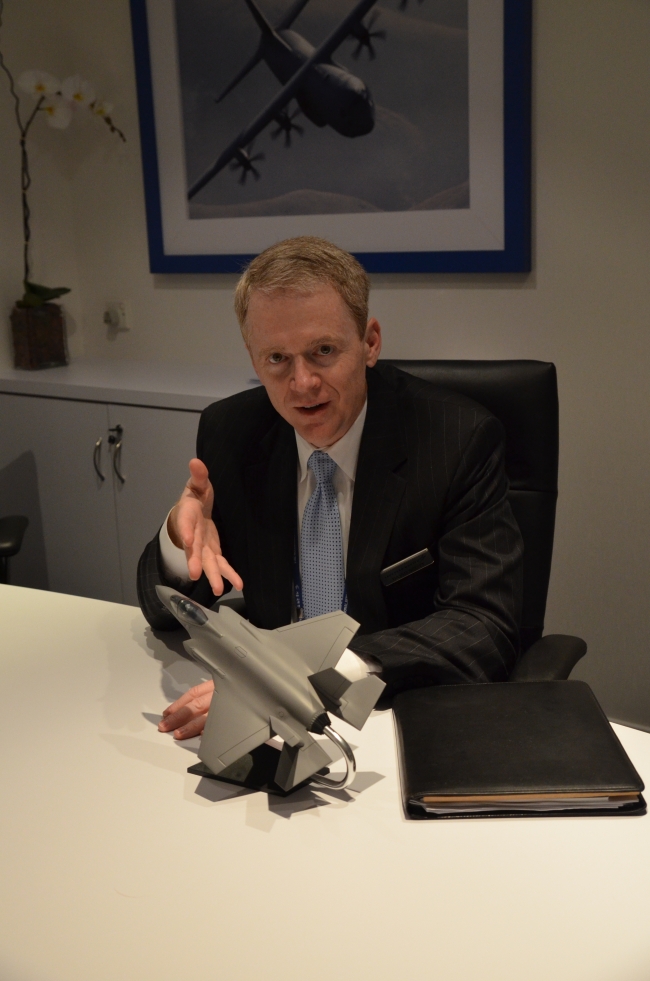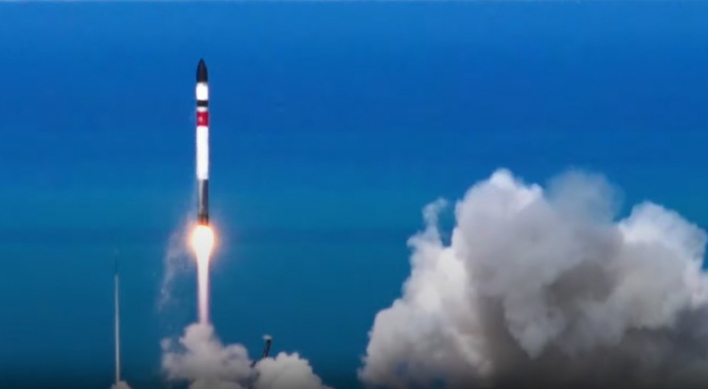Lockheed Martin touts F-35’s strengths in future combat
Executive stresses lower costs for acquisition and maintenance
By Korea HeraldPublished : Oct. 31, 2013 - 20:04
Following is the second in a two-part series of interviews with the two major arms contractors that bid for the nation’s next-generation fighter jet project. The first on Thursday was with Boeing Co. ― Ed.
U.S. defense firm Lockheed Martin highlighted its fighter F-35’s capabilities optimized for future combat conditions, saying that other current generation warplanes had reached the point where “breakthrough” technologies are difficult to incorporate.
Dave Scott, director of F-35 International Business Development, also noted that stealth was not the only “fifth-generation” feature of its fighter, as he talked of Seoul’s move to acquire radars to detect stealth aircraft during an interview with The Korea Herald.
U.S. defense firm Lockheed Martin highlighted its fighter F-35’s capabilities optimized for future combat conditions, saying that other current generation warplanes had reached the point where “breakthrough” technologies are difficult to incorporate.
Dave Scott, director of F-35 International Business Development, also noted that stealth was not the only “fifth-generation” feature of its fighter, as he talked of Seoul’s move to acquire radars to detect stealth aircraft during an interview with The Korea Herald.

“Stealth has to be designed from the beginning. We have to align the edges, conceal the engine at the back, make it very smooth, and embed sensors, internal weapon bays and internal fuel carriage,” he said at the ongoing international defense and aerospace exhibition at KINTEX in Ilsan.
“You can’t do that with the existing airplanes. So, the fifth-generation airplane provides a real breakthrough level of capabilities.”
On top of radar-evading capability, Scott underscored other less-noted F-35 features such as advanced sensors, aerodynamic performance, helmet-mounted situational awareness displays, and electronic warfare capability 10 times stronger than dedicated jamming aircraft.
He added that compared with other warplanes, the cost of incorporating new capabilities and maintenance would be lower given that more customers around the world would begin using the brand-new plane.
From the early stages of the competition, the F-35’s air force variant, or F-35A, garnered the most media attention as it was the only all-aspect stealth plane among the candidates, which also included Boeing’s F-15 Silent Eagle and European Aeronautic Defense and Space Company’s Eurofighter Typhoon.
But it was not short-listed in September as it failed to stay within Seoul’s 8.3 trillion won ($7.8 billion) budget for the project.
Amid criticism that the government focused too much on the price tag, Seoul has decided to restart the project. Observers and officials are concerned the decision could cause a delay in the plan to deploy 60 high-end warplanes from 2017-2021.
Scott expressed confidence about the delivery commitment despite worries about a possible delay.
“The offer that the U.S. government and Lockheed Martin submitted included deliveries beginning as early as 2017, and we can still maintain those deliveries if there is a decision made to proceed forward in the near future,” he said.
Touching on the acquisition cost, Scott reiterated that Korea would be in the “sweet spot” of the cost curve as the production of the F-35 would ramp up with more customers placing orders.
“The cost of the F-35 has come down substantially. From the first-year production to the seventh-year production, we decreased the price by 55 percent and we will continue to decrease that price as we increase the production rate,” he said.
“The U.S. government projects the F-35A model ordered in 2018 and delivered in 2020 will be $85 million for the airplane. To that, we need to add spares, support and training and other things that go to create a full capability for the ROKAF (Republic of Korea Air Force). But that is a very competitive price compared to current generation planes.”
Lockheed Martin currently has 75 F-35s flying in the test, training and initial operational fleets. They have completed around 6,500 flights, flying over 10,000 hours altogether. The U.S. Air Force aims to achieve initial operational capability with the F-35A in late 2016.
Scott said the development of the F-35 software was on track. Now, the “Block-2A” software is being tested with a plan to complete the final combat-capable Block 3-F version in late 2016.
Launched in 2001, the F-35 “Joint Strike Fighter” project is a multinational program joined by the U.S. and eight foreign partners ― Britain, Italy, the Netherlands, Turkey, Canada, Australia, Denmark and Norway.
The reputation of the project has been marred by the discovery of defects, surging costs and development delays.
The single-seat, single-engine F-35 jet has three different variants. The conventional takeoff and landing F-35A is for air force operations, while the F-35B is the Marine Corps’ short take-off and vertical landing variant and the F-35C is the Navy’s carrier-based version.
By Song Sang-ho (sshluck@heraldcorp.com)
“You can’t do that with the existing airplanes. So, the fifth-generation airplane provides a real breakthrough level of capabilities.”
On top of radar-evading capability, Scott underscored other less-noted F-35 features such as advanced sensors, aerodynamic performance, helmet-mounted situational awareness displays, and electronic warfare capability 10 times stronger than dedicated jamming aircraft.
He added that compared with other warplanes, the cost of incorporating new capabilities and maintenance would be lower given that more customers around the world would begin using the brand-new plane.
From the early stages of the competition, the F-35’s air force variant, or F-35A, garnered the most media attention as it was the only all-aspect stealth plane among the candidates, which also included Boeing’s F-15 Silent Eagle and European Aeronautic Defense and Space Company’s Eurofighter Typhoon.
But it was not short-listed in September as it failed to stay within Seoul’s 8.3 trillion won ($7.8 billion) budget for the project.
Amid criticism that the government focused too much on the price tag, Seoul has decided to restart the project. Observers and officials are concerned the decision could cause a delay in the plan to deploy 60 high-end warplanes from 2017-2021.
Scott expressed confidence about the delivery commitment despite worries about a possible delay.
“The offer that the U.S. government and Lockheed Martin submitted included deliveries beginning as early as 2017, and we can still maintain those deliveries if there is a decision made to proceed forward in the near future,” he said.
Touching on the acquisition cost, Scott reiterated that Korea would be in the “sweet spot” of the cost curve as the production of the F-35 would ramp up with more customers placing orders.
“The cost of the F-35 has come down substantially. From the first-year production to the seventh-year production, we decreased the price by 55 percent and we will continue to decrease that price as we increase the production rate,” he said.
“The U.S. government projects the F-35A model ordered in 2018 and delivered in 2020 will be $85 million for the airplane. To that, we need to add spares, support and training and other things that go to create a full capability for the ROKAF (Republic of Korea Air Force). But that is a very competitive price compared to current generation planes.”
Lockheed Martin currently has 75 F-35s flying in the test, training and initial operational fleets. They have completed around 6,500 flights, flying over 10,000 hours altogether. The U.S. Air Force aims to achieve initial operational capability with the F-35A in late 2016.
Scott said the development of the F-35 software was on track. Now, the “Block-2A” software is being tested with a plan to complete the final combat-capable Block 3-F version in late 2016.
Launched in 2001, the F-35 “Joint Strike Fighter” project is a multinational program joined by the U.S. and eight foreign partners ― Britain, Italy, the Netherlands, Turkey, Canada, Australia, Denmark and Norway.
The reputation of the project has been marred by the discovery of defects, surging costs and development delays.
The single-seat, single-engine F-35 jet has three different variants. The conventional takeoff and landing F-35A is for air force operations, while the F-35B is the Marine Corps’ short take-off and vertical landing variant and the F-35C is the Navy’s carrier-based version.
By Song Sang-ho (sshluck@heraldcorp.com)
-
Articles by Korea Herald


![[Exclusive] Korean military set to ban iPhones over 'security' concerns](http://res.heraldm.com/phpwas/restmb_idxmake.php?idx=644&simg=/content/image/2024/04/23/20240423050599_0.jpg&u=20240423183955)
![[AtoZ into Korean mind] Humor in Korea: Navigating the line between what's funny and not](http://res.heraldm.com/phpwas/restmb_idxmake.php?idx=644&simg=/content/image/2024/04/22/20240422050642_0.jpg&u=)


![[Graphic News] 77% of young Koreans still financially dependent](http://res.heraldm.com/phpwas/restmb_idxmake.php?idx=644&simg=/content/image/2024/04/22/20240422050762_0.gif&u=)












![[Today’s K-pop] Ateez confirms US tour details](http://res.heraldm.com/phpwas/restmb_idxmake.php?idx=642&simg=/content/image/2024/04/23/20240423050700_0.jpg&u=)